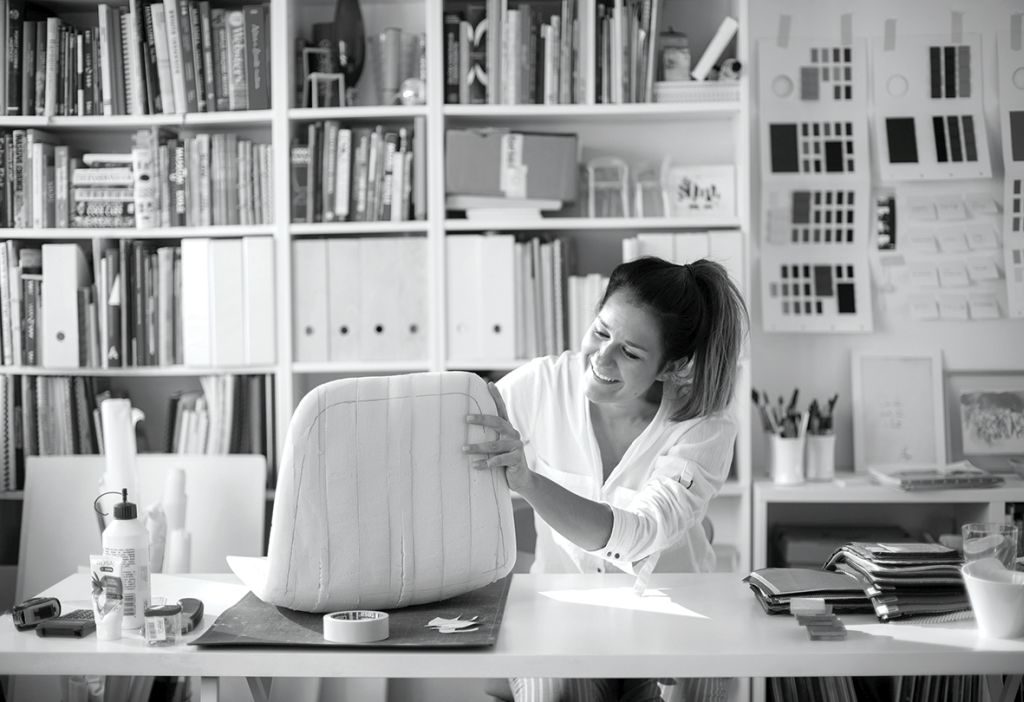Nataša Perković, product designer: “Experts from all over the world recognize Bosna and Herzegovina design and production as innovative”
"Art does not prove anything directly. She shows. It cannot be an argument, but an intervention in a living, concrete reality, a transposed documentation in its real-life environment.”
(Mito Vasilev)
Nataša Perković, a product designer, esthete, and nature lover, strives to design highly aesthetic products, which will beautify people’s lives and which they will use for a long time, preferably products that she will give to her children, also strives for perfection of creation. Such products are products with a long lifespan, at the same time sustainable, and have a beneficial effect on the environment. The environment is an art that smolders in our eyes and awaits its expression.

Precisely such products are the result of the mission of one of “those” who let their dreams be dreamed and revealed, live their ambitions and aspirations that they will bring a new tomorrow with them, remembered, and that to the world climate. Something of ours.
She graduated from the Department of Product Design at the Academy of Fine Arts, University of Sarajevo. Towards the end of her studies, she was on an exchange at the Cittadellarte creative center – FondazionePistoletto, founded by the great artist Michelangelo Pistoletto. The foundation is located in Biella, between Milan and Turin, and in the heart of Italian industry, so it has given her the opportunity to continue cooperation with the foundation and develop several products with these outstanding productions. She then did an internship at ThePartners, a leading graphic design agency in London, where she learned how a design bureau should be structured and realized how much design is related to business.
After these and many other experiences, she returned to Sarajevo and started working with our companies, which were sometimes less and sometimes more interested and generally familiar with what design is. Today she is a teaching assistant at the Academy of Fine Arts, University of Sarajevo.
How did your academic career begin?
I started my academic career as an assistant to academician and professor emeritus Zlatko Ugljen and professor emeritus Ognjenka Finci. I am grateful for the opportunity to learn how to encourage students to discover their aesthetic affinities and to realize themselves as creatives and authors. I am privileged to have the opportunity today to lead the course, and work with and influence talented young people.
-1654853969.jpg)
-1654854049.jpg)
They say that people really have to love their job, in order to be extremely dedicated to it and do it with one hundred percent personal investment, close to perfection. Is it your case?
My academic career gives me an incentive to set a high standard for my practical work, I try to make all of my projects a contribution to the profession at large, and that is why I turned to cooperation with domestic furniture manufacturers. At that time, the furniture industry was maturing, it was, for the first time since the war, ready to develop its own product, most often for the international market, and for that, they needed a design. It is precisely such companies that have had the potential to develop a product that is a contribution to the profession. Several companies have emerged that have realized the advantage of their own product and created the technical, market, and other conditions to go down that path. This is actually more complex than it sounds, roughly like you’re heading across the sea in the dark in a small boat with a small engine, instead of staying in your cove. I think every businessman from Bosnia and Herzegovina who embarks on the development of his brand is a brave adventurer. It is extremely interesting to be a part of that adventure.
-1654854138.jpg)
What is the level of Product Design, more precisely furniture design, in BiH at this moment?
Product design or, more specifically, furniture design in Bosnia and Herzegovina is at an extremely high level if we look separately at the activities of individuals in product design, ie in furniture design. However, if we look at the whole product design scene, it is almost non-existent. As far as I know, we do not have a single studio that deals exclusively with product design or furniture design, designers are not professionally united, there is no culture of design exhibition in galleries or museums, there is no criticism, and many other similar things. It would be good if more designers have the opportunity to work with more industries, not just the furniture industry, which is currently our most active. All this would be important for building a scene that is stable, that can be present for a long time, and which would be the branded “bh. design”. All this is possible, it just needs to be a strategic priority and for all important actors to work towards the same goal, to swim in the same direction.
Despite this, individuals are truly brilliant, individual products are excellent. Every year when I visit ImmCologne – International Fair in Cologne, one of the most important furniture fairs in the world, I can't help but get the impression that our designers are brave, fresh, and extremely productive. For years bh. products make up about half of my list of the top ten most interesting products from the entire fair. My assessment is completely subjective, but objectively experts from all over the world recognize BiH design and production as innovative. Perhaps the nascent industry does not have much to lose and allows experimentation, so it will be very important to continue to develop the industry and maintain a penchant for bold moves. And, of course, it has to strategically develop all the elements of the scene.
-1654854260.jpg)
-1654854396.jpg)
What contributed to the positive climate for the development of domestic design?
It could be said that the Bosnian-Herzegovinian furniture industry is currently being reborn. Our tradition of working with wood and the production of wooden furniture is centuries old. Industrial production in the true sense of the word began in Yugoslavia, and in the 1980s, large state-owned companies had designers in their ranks, as well as architects who designed products. After the war, privatization took place, and the newly formed small private companies mostly no longer made such complex products as furniture at all, nor did they offer their own design, but worked as subcontractors for other companies. The bravest stood out, gathered knowledge, and secured resources to develop their products. In my opinion, a very important role was played by people who before the war gained experience in companies that developed their products, among them managers and engineers, and designers. They are the link and transmitter of knowledge and experience and they have enabled such a high quality of all aspects of the product. Of course, the role of the Product Design Department at the Academy of Fine Arts in Sarajevo is significant in this regard.
It is also very important that among entrepreneurs stood out those who wanted to have their own product and enter the race for their own market, while others worked exclusively on behalf of other companies with contracts that were secure. We even started calling our own product “designed” furniture. These entrepreneurs have recognized the strategic role of design in business development, that investing in design pays off the manifold. In the absence of large teams to assess the quality of the conceptual design and products in development, entrepreneurs would give designers the freedom to work. The final product that would result from that freedom would often be honest, alive, fresh, and the market recognizes it. This is not always the case in developed industrial systems, where the product goes through numerous levels of decision-making and sometimes loses its immediacy and freshness.
-1654854725.jpg)
-1654854752.jpg)
To what extent is your Elle collection actually an expression of femininity and mysterious, subtle beauty? What is its greatest specificity, perhaps one word that would represent a collection anywhere and forever? Is it, at its core, strictly bh. product or is there a significant impact of knowledge gathered during the rise of your career outside BiH in it?
I developed the Elle collection with the Bosnian-Herzegovinian company MS & Wood. I envisioned Elle as the embodiment of sophisticated beauty. Elle is both sculptural and the fruit of a modernist approach to design. Each piece that is part of this line is characterized by a complex shape developed through a play of round volumes and sharp edges, but its silhouette is extremely simple. In the aesthetic sense, Elle is on the border between character and neutral. It may be in the foreground. Its shapes vary when viewed from different perspectives and any change in lighting on them reveals a wealth of detail. On the other hand, it is not dominant and can be an everyday use item that we notice when we need it and that responds to our functional requirements. Parts of the collection can fit well in different interiors or in one home whose style changes over the years.
I developed the design by hand making a large number of models in scale and real size from materials such as cardboard, cardboard and styrofoam. Computer modeling served only to transfer the hand-made form into a technical language understood by engineers, masters, but also CNC machines. The role of computer modeling today is unquestionable in design. Computers speed up and simplify our work, but it seems to me that designing with software alone can limit individual authorial expression. Designing through physical design makes it easier to understand different aspects of the product: shape, function, ergonomics, the proportion of parts in relation to the whole, etc. I think the Product Design Department at the Academy of Fine Arts in Sarajevo is special in that it still nurtures this Bauhaus approach to design.
I check the general technical aspects of each new solution through the designs and principles of the golden ratio. In the case of Ella, the biggest challenge was to physically thin the solid wood elements as much as possible, while leaving enough space for solid joints, i.e. to visually lighten the elements that had to remain thicker. After that, the engineers in the factory started working on technical development.
-1654854799.jpg)
My dream is for the Elle collection to be in many homes and for many people to enjoy it for many years to come. I would like MS & Wood to produce Elle for a long time to come and for the collection to provide jobs for many workers.
-1654851447.jpg)
 (1)-1640087710.jpg)
-1640087627.jpg)







